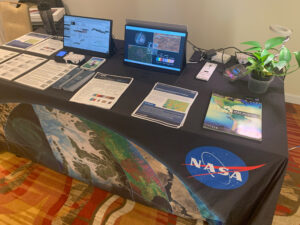Source: USGS
- Effective January 1, 2010, the calibration of the ETM+ thermal band was modified to correct for a lifetime gain error detected by the vicarious calibration teams. Changes were made to the Calibration Parameter File (CPF) to correct a gain error that has been present since the launch of the instrument. This gain error causes the thermal band to predict too hot at cold temperatures and too cold at hot temperatures. For instance, a target with an at-satellite temperature of 0 C will appear to be 0.8 C based on the image data and a target with an at-satellite temperature of 27 C will appear to be 26.3 C. The error at 12 C is approximately 0 C. The vicarious calibration data were used to generate a correction to the calibration and the corrected coefficients were implemented in the processing system on Jan 1, 2010. All data processed by the USGS/EROS processing system after Jan 1, 2010 are correctly calibrated.
The vicarious calibration teams, the Rochester Institute of Technology and the NASA/Jet Propulsion Laboratory, have been collecting data under the satellite since the instrument launched in 1999. Early in the mission, they detected an offset error of 0.31 W/m² sr µm (Barsi, 2003). This was corrected in the processing system in October 2000. Since then, the teams have continued to collect field data. The addition of a site on the Salton Sea, which can get as hot as 35 C in the summer, expanded the temperature range over which the teams acquired ground truth. With these hot points, a gain error of 5.8% became statistically significant. The effect of this gain error is that the instrument was estimating that hot targets were too cold and cold targets were too hot. See the table below for estimates of the error on specific target temperatures.
The error was corrected by adjusting the internal-to-external gain ratio in the Calibration Parameter File (CPF). Other parameters needed to be adjusted for non-default processing conditions, but for most users, the internal-to-external gain ratio is the only parameter that will affect the product. Users should note that with the current distribution system, the downloadable product may not have been processed with the latest CPF. Please check the “Product Creation Time” in the metadata file (MTL) that comes with the downloaded product to ensure that the product is processed after January 1, 2010.
| Target temperature | Approximate Radiance (W/m² sr µm) |
Estimated Calibration Error (K) |
| 273K / 0 C | 6.0 | 0.8 too hot |
| 285K / 12 C | 7.5 | 0 |
| 300K / 27 C | 9.0 | 0.7 too cold |
————-
J.A. Barsi, J.R. Schott, F.D. Palluconi, D.L. Helder, S.J. Hook, B.L. Markham, G. Chander, E.M. O’Donnell (2003). Landsat TM and ETM+ thermal band calibration, Canadian Journal of Remote Sensing, vol. 29, no. 2, pp. 141–153.






